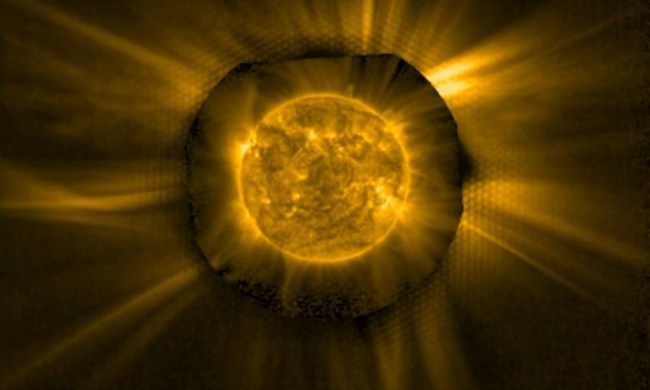 This artist’s concept depicts a potential volcanic moon between the exoplanet WASP-49 b, left, and its parent star. New evidence indicating that a massive sodium cloud observed near WASP-49 b is produced by neither the planet nor the star has prompted researchers to ask if its origin could be an exomoon.
NASA/JPL-Caltech
This artist’s concept depicts a potential volcanic moon between the exoplanet WASP-49 b, left, and its parent star. New evidence indicating that a massive sodium cloud observed near WASP-49 b is produced by neither the planet nor the star has prompted researchers to ask if its origin could be an exomoon.
NASA/JPL-Caltech
We know there are thousands of planets beyond our solar system, called exoplanets. And scientists are pretty sure that many of these planets must also host moons, called exomoons. But because moons are so tiny and dim compared to planets and stars, there has never been a confirmed discovery of an exomoon. Now, though, scientists have uncovered evidence of an exomoon, and it appears to be a hellish and volcanic place.
The possible moon is in orbit around WASP-49 b, a gas giant located over 600 light-years away that orbits its star so closely that a year there lasts just 2.8 days. The evidence for the moon comes in the form of a cloud of sodium that appears to be moving slightly differently from the planet, suggesting it could be linked to its own body.
The presence of sodium is similar to what is seen at Jupiter’s moon Io, which is covered in hundreds of volcanoes and is the most volcanically active place in the solar system. These volcanoes are constantly erupting and spewing out material including sulfur dioxide, sodium, potassium, and other gases, which can be thrown out for hundreds of miles and can form huge clouds that are bigger even than Jupiter.
When researchers used the Very Large Telescope to observe the WASP-49 system, they found a comparable-looking cloud of sulfur, which is why they think there might be a volcanic moon there.
“We think this is a really critical piece of evidence,” said lead researcher Apurva Oza of the California Institute of Technology in a statement. “The cloud is moving in the opposite direction that physics tells us it should be going if it were part of the planet’s atmosphere.”
Another piece of evidence for the existence of a moon is that while both the planet and its star do have small amounts of sodium, there isn’t enough present to explain the size of the cloud.
“The evidence is very compelling that something other than the planet and star are producing this cloud,” said fellow researcher Rosaly Lopes of NASA’s Jet Propulsion Laboratory. “Detecting an exomoon would be quite extraordinary, and because of Io, we know that a volcanic exomoon is possible.”
The dramatic nature of this moon, however, should it exist, will be its undoing. Io is heated internally due to the enormous gravitational forces of Jupiter, which is what keeps powering its volcanoes. But this exomoon is throwing out so much material and must be under such gravitational strain that the researchers think it will eventually disintegrate.
“If there really is a moon there, it will have a very destructive ending,” said Oza.
The research is published in The Astrophysical Journal Letters.

Georgina has been the space writer at Digital Trends space writer for six years, covering human space exploration, planetary…
NASA’s Juno spacecraft to pass within 1,000 miles of volcanic moon Io

NASA's Juno spacecraft, currently in orbit around Jupiter, will soon be making a close flyby of one of the planet's most dramatic moons, Io. On Saturday, December 30, Juno will come within 1,000 miles of Io, making it the closest spacecraft to that moon in the last 20 years.
Io is an intriguing place because it shows signs of significant volcanic activity, making it the most geologically active body in the solar system. It hosts over 400 active volcanoes, which periodically erupt due to hot magma inside the moon created by friction caused by the gravitational pull between Jupiter and its other large moons.
Read more
James Webb sees evidence of an ocean-covered ‘Hycean’ exoplanet

The James Webb Space Telescope has once again peered into the atmosphere of an exoplanet, and this time it has identified indications that the planet could be covered in oceans. The planet K2-18 b is just 120 light-years away from Earth in the constellation of Leo and is a type of planet called a sub-Neptune which is unlike any planet in our solar system.
Researchers used Webb to investigate K2-18 b, which is more than eight times the mass of Earth and orbits a small, cool dwarf star. It is located within the habitable zone of the star, where it is possible for water to exist on the planet's surface, and the data suggests that this could be an ocean world.
Read more
Scientists ‘hack’ Solar Orbiter’s camera to get a better look at the sun

The European Space Agency's (ESA) Solar Orbiter spacecraft is performing a long series of flybys of various planets to bring it closer and closer to the sun on each pass. It will eventually come within 26 million miles to observe the sun up close, and enter in the orbit of Mercury. It will be the closet a camera has ever gotten to the sun, in order to take detailed images of the sun's corona and its local environment.
A new way to view the Sun
Read more




















 English (US) ·
English (US) ·